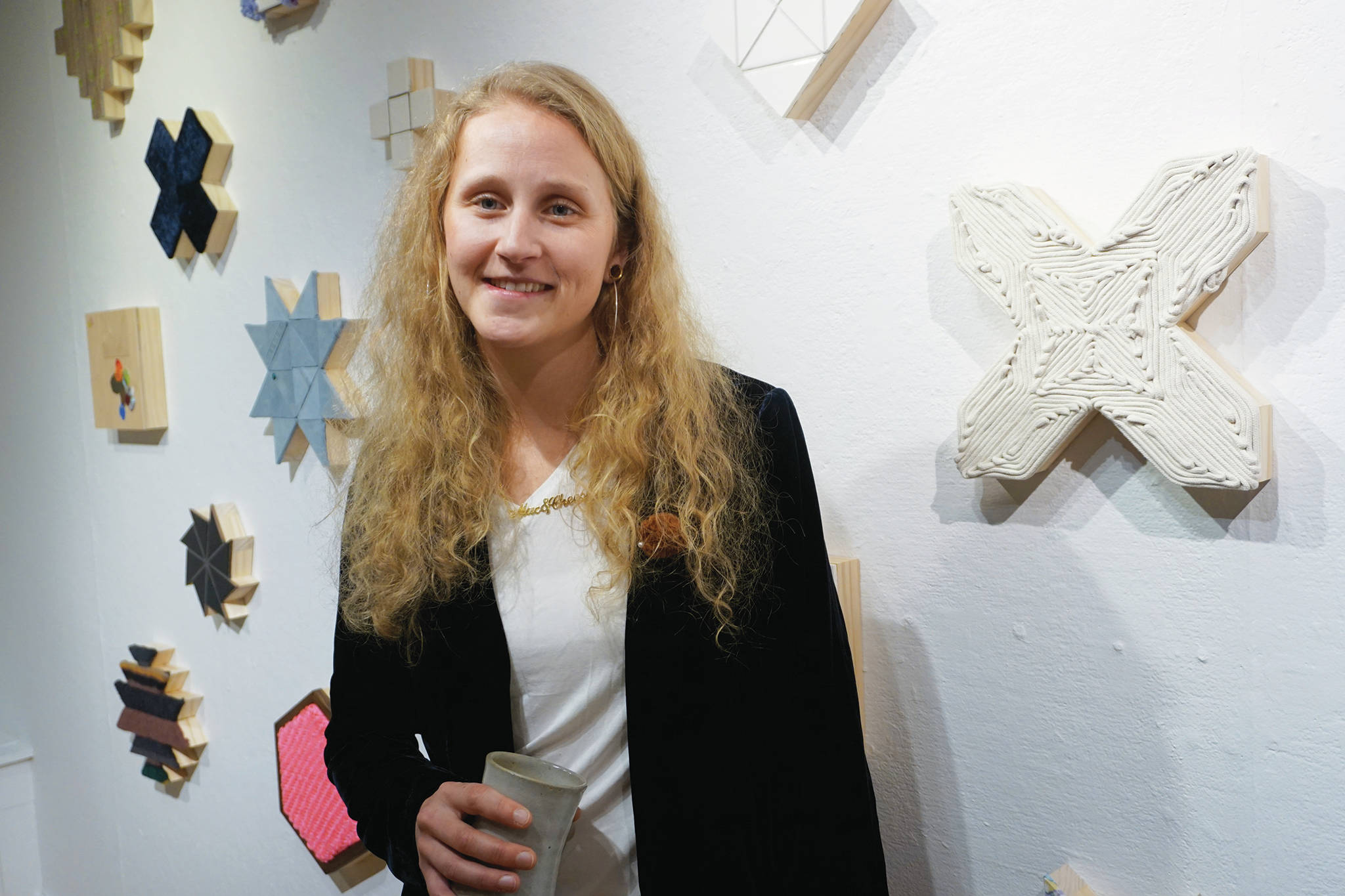‘Macaroni and Cheese,” Fairbanks artist Tamara Wilson’s art show and installation at Bunnell Street Arts Center, appears to be a room of domestic tranquility with a bit of 1980s nostalgia.
Agave-print wallpaper lines two walls of the room. A refrigerator door has brightly-colored alphabet magnets stuck to it, the letters spelling out “oh, please,” as if a surly teenager had left a mark after a midnight cold pizza run.
A white radiator casts the feeling of warmth on the room. Colorful paintings hang on the wall next to a bright orange rotary dial phone, the handset connected by a long extension cord, the way people talked before cordless handsets or cellphones.
And it’s all made of felt.
“I think the main draw to it is as a typical craft material,” Wilson said in a phone interview. “… Everyone has a memory with that kind of super-synthetic material, those colors, cutting it out and gluing and glitter.”
Wilson, 33, hung her show and did the installation recently for a two-week Artist in Residence at Bunnell. On Feb. 7 she introduced the exhibit in a First Friday artist’s talk before heading back to Fairbanks. The room installation dominates the show. She said the idea is about “wanting to share that world with people.”
“How can people step into the art world that I have learned to love?” Wilson said in her artist’s talk. “… You guys become the art because you’re now inside the painting.”
Born and raised in Fairbanks, Wilson got her bachelor’s degree at the University of Alaska Fairbanks and a master of fine arts from the University of New Mexico in Albuquerque. At UAF she studied with the artists Laura Hewitt and Rachelle Dowdy, both Bunnell artists.
Hewitt inspired Wilson to take her art seriously, Wilson said.
“It wasn’t messing around,” she said Hewitt told her. “… This was a real discipline.”
Not that there isn’t a lot of playfulness in Wilson’s art. At her Bunnell artist talk, Wilson said the artist Philip Guston helped her see the fun in art. Guston had moved away from abstract expressionism into figurative art, and when someone asked him how he could do that, he said it brought him joy.
“It put this seed in my head that it’s OK to investigate these delightful things, to explore joy,” Wilson said. “It’s about having fun and playing. Why can’t we do this as adults?”
As a girl, Wilson learned to sew from her mother, who had gotten annoyed at Wilson changing her Halloween costume ideas at the last minute and so told her to make her own outfits. Wilson started out painting but eventually moved into using fabric as her media.
“When I started incorporating that into my art work, I was using it because it was a language, because it was part of what I was,” she said.
Fabric and sewing has the stereotype of being women’s work. Wilson admits there’s a domestic theme in her art.
“I realized this last show when I was installing the radiator … In most of my shows I have a source of heat,” she said. “I feel like in many ways I’m making a small home. I’m making a little mess.”
Some of her work uses materials and crafts that have the stereotype of being men’s work, like flooring and cabinetry. Wilson built her own studio and home, and would work at jobs just to learn a certain skill. In one installation at Bunnell, “Material Quilt,” the pieces of the quilt — an array of constructions — have both fiber and material. One piece is an upholstered cushion with a silver duct tape repair. Another is a cabinet salvaged from a construction job she did.
“I respected all those skills that are stereotypical men’s work,” Wilson said. “I realized what I’m doing is mixing the two. It doesn’t matter. It’s no longer a conversation about the expectations of your gender. It’s a new language entirely.”
That combination, where an artist can both sew and saw, can transcend gender norms.
“I realize I’m like that in my own life,” Wilson said. “I’m not either or. I’m Tamara. I’m just me who does my stuff.”
The title of her show, “Macaroni and Cheese,” has to do with the her feelings about the meal as a comfort food. It can be bland and boring, she said, but also with the addition of spices and ingredients become “this extraordinary dish.”
“I feel like that’s what the art world is for me, taking what makes you feel good and what you see good out of it,” she said. “…You can use it to communicate a lot of other different things as well, but it’s really how you use it and how you enjoy it.”
The agave design in her wallpaper also has another meaning, Wilson said.
“I like how ordinary it is. It’s an unassuming, spiky, bush-like thing,” she said. “These giant blossoms six-feet tall grow out of the middle, and then it dies. … It’s such a useful plant, too, It makes fabric. I like the duality of a thing that makes things. … tequila and agave sugar. … I felt like it needed to be celebrated.”
Wilson has been using her craft skills on another project, the Lemonade Stand, an alternative exhibit space. She found a 1966 13-foot trailer at Summit Lake north of Delta Junction and did a frame-up renovation. It has its original aluminum skin, but was totally gutted.
The Lemonade Stand will be a place artists can do installation art who might not have access to galleries.
“Artists could do all the things they wish they could in other places,” she said. “…They could bring an art experience to places that don’t have established galleries in their community.”
For more on the Lemonade Stand see her photos on Instagram @lemonadester; for her work go to @tamarakwilson.
Reach Michael Armstrong at marmstrong@homernews.com.

